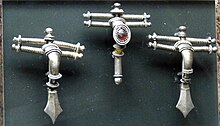Haßleben-Leuna Group
The Haßleben-Leuna Group is an archaeological cultural group from the late Roman Empire in the Middle Elbe-Saale region . It is named after a burial ground from Haßleben and one from Leuna .
Research history
In 1834 a very richly decorated grave from around 300 AD was discovered during gravel mining near Leuna in Saxony-Anhalt. The found objects were first in private hands, then in the art trade and were finally bought by the British Museum in London. The first elite grave of the Haßleben-Leuna group has since been exhibited in London.
In 1912, workers near Haßleben in Thuringia discovered a grave similar to that in Leuna. A young woman was buried in a small cemetery with several richly decorated graves. Her grave furnishings with precious pieces of jewelry made of gold and silver, Roman glasses and metal vessels exceeded everything that was previously known. The find of Haßleben remained the richest Germanic princely grave in Germany for almost 100 years.
The Leuna grave finds from around 300 AD, discovered in 1917 and 1926, have been kept by the State Museum of Prehistory in Halle (Saale) since they were recovered. These graves also contained rich additions made of precious metal as well as rare imported pieces from the Roman Empire.
With the scientific processing of the grave finds from Haßleben and Leuna, Walther Schulz wrote two fundamental works on the Haßleben-Leuna group.
However, many older sites could no longer be researched afterwards, as they had already been improperly destroyed when they were discovered.
In 1990 the princely grave of Gommern near Magdeburg was discovered by chance , immediately secured and examined in an almost undisturbed condition. This is the first time that a planned archaeological investigation using modern methods has been carried out in Gommern.
Grave finds
Characteristic for the Haßleben-Leuna group are body burials with sometimes extremely rich grave goods. These additions include gold jewelry ( fibulae , neck rings, finger rings), Roman imported objects ( gold coins , bronze dishes, glasses or ceramics), spurs as signs for mounted people, silver arrowheads (not usable) , board games as an indication of demanding leisure activities, as well as local products like handmade ceramics.
Dating
In addition to the relative dating to the younger imperial period, Roman imported pieces offer good absolute dating information. Gold coins of the Gallic special emperors have been found several times , which justify a coin dating to the late 3rd and early 4th centuries.
Connections to the Roman Empire
Imported objects and coins suggest that the bearers of the Haßleben-Leuna group had intensive contacts with the Roman Empire. They were probably in Roman service as mercenaries and then returned to their homeland.
Technology transfer
In Haarhausen one was pottery complex excavated, was made in the 3rd century AD in the late hub ceramic according to Roman models in pottery kilns, which also Roman Oven forms are modeled. The sponsors of the Haßleben-Leuna Group were obviously trying to secure a supply of goods through technology transfer.
Connections to Bohemia
More recent research (Droberjar 2007) showed that from the second half of the third century a strong influence of the central German Haßleben-Leuna group in north-west and east Bohemia can be shown. First and foremost, this concerns the neck rings, which are usually provided with pear-shaped closures, the folding cups, the turntable ceramics and the so-called "Elbe fibulae" ("Elbe brooches"). In addition, there is a relatively high concentration of "rich" body graves in Bohemia compared to the grave goods from cremation graves from the late imperial era - evidence of the existence of a local Germanic elite.
Droberjar researched the women's graves of Soběsuky (Blažek 1995, pp. 145–148), Slepotice (Beková - Droberjar 2005) and Hostivice (unpublished). In search of comparisons for three of the richest recently examined graves from the late imperial era in Bohemia, he came to the so-called "chief graves" in central Germany and Poland and found that the grave goods belong to the richest women's graves, which have neither bronze , Silver and glass vessels or other luxurious items.
Isolated old finds with a context that cannot be further identified, such as the splendid gold earrings from Chlumine, a few silver spurs from the Litoměřice region or the massive gold bracelets from the Prague Basin show that the highest Germanic (Suebi) elite existed in Bohemia.
literature
- Walther Schulz : The princely grave of Haßleben. Berlin, Leipzig 1931.
- Walther Schulz: Leuna. A Germanic burial place from the late Roman Empire. Berlin 1953.
- Wolfgang Schlueter : Attempt to differentiate the body grave group from Haßleben-Leuna from the early days of the imperial era based on an analysis of the grave finds. New excavations and research in Lower Saxony 6, 1978, 117–145 (with a compilation of the burials known at that time).
- Sigrid Dušek : Roman craftsmen in Germanic Thuringia. Results of the excavations in Haarhausen, Arnstadt district. Stuttgart 1992, ISBN 978-3806210620 .
- Siegfried Fröhlich : Gold for eternity. The Germanic princely grave of Gommern: Accompanying volume for the special exhibition in the State Museum for Prehistory Halle (Saale), October 18, 2000 to February 28, 2001. Halle 2000, ISBN 978-3910010550 .
- Mario Becker : Gommern. In: Reallexikon der Germanischen Altertumskunde (RGA). 2nd Edition. Volume 12, Walter de Gruyter, Berlin / New York 1998, ISBN 3-11-016227-X , pp. 395-399. (on-line)
- Sigrid Dušek: Hatred life. In: Reallexikon der Germanischen Altertumskunde (RGA). 2nd Edition. Volume 14, Walter de Gruyter, Berlin / New York 1999, ISBN 3-11-016423-X , pp. 41-43. (on-line)
- Mario Becker: Leuna. In: Reallexikon der Germanischen Altertumskunde (RGA). 2nd Edition. Volume 18, Walter de Gruyter, Berlin / New York 2001, ISBN 3-11-016950-9 , pp. 299-302. (on-line)
- Eduard Droberjar: New findings on the princely graves of the Hassleben Leuna Gommern group in Bohemia . In: Přehled výzkumů 48. 2007, pp. 93-103.
Web links
- Haßleben's grave find in the Arachne archaeological database
- Image of the golden two-scroll brooches
- Primer from Leuna (1926)
